Supply Chain Performance of Airbus
Describe about the Supply Chain Management for the Case Study of Airbus.
The aerospace industry has recorded a consecutive increase in the sales continuously from last three years. Supply chain management is becoming the key element for the development of the aviation industry (Gopalakrishnan et al. 2012). The complexities and risk factors mainly lie in the section of supply and management of the company. This report is made to focus on the importance of supply chain management in an organization for its smooth and reliable operation.
In consideration of the globally established value chain analysis among the aerospace industry involves the completion of the customer requirements. There is no violation of this aspect in case of the Airbus. The production network is combing several factors: functions of the suppliers, transporters, retailers, manufacturers, etc. Airbus is focusing on the wide process of outsourcing. This aspect is totally related to the supply chain management of the organization (Khajavi, Partanen and Holmstrom 2014). The example of value chain analysis can be explained by: Airbus and Boeing together has introduced B787 and A350XWB, which involves more complex work packages in comparison with the previous programs, though it is used to reduce the time and cost involved.
The supply chain management is totally dependent on the working culture of the stakeholders of any organization. Airbus also provides importance to their employees for managing the value chain within the industry (Martinez-Jurado and Moyano-Fuentes 2014). The strategically involved suppliers and other stakeholders of the Airbus first examine the subsystems and crucial parts of the organization, this aspect builds good relationship with the suppliers, customers and the employees of the organization. Airbus launched packages according to the risk shared with the suppliers. The losses considered for the suppliers or external people involved in the organization are added with the cost involved in manufacturing the product or services. This aspect makes the suppliers more responsible with their work that involves the setting up of packages, and improvement of the scope of the work, etc. (Mena, Humphries and Choi 2013). The improvement of the working culture in Airbus, the management adds new programs for involving the experienced suppliers for getting better production.
Airbus organization has taken up new initiatives to increase their supply chain resilience. In this organization, the supply chain process is quite complex, and disruption occurs due to resource constrains, quality and communication issues, environmental events and supplier's insolvency. From the following statistical graph, these illustrations can be better understood.
Working Process of the Supply Chain in Airbus
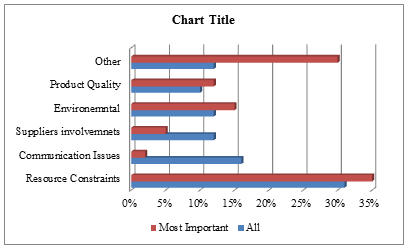
Figure 1: Supply Chain Disruptions
(Source: Liu, Kasturiratne and Moser 2012, pp-585)
The strategy management process of Airbus organization is as follows
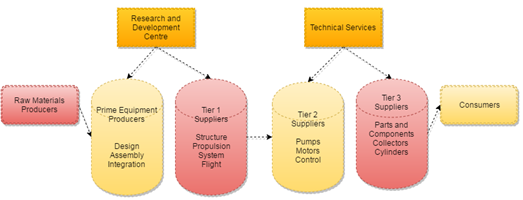
Figure 2: Supply Chain Management of Airbus
(Source: Golicic and Davis 2012, pp-730)
The major actors of Airbus' management process are suppliers, manufacturers, transporters, retailers, and customers. In the research and development center, the manufacturers use raw materials to produce the best quality of aircraft products to the customers (Aung and Chang 2014). The first tier suppliers assemble the major parts of the system such as engines, interior, gear, and avionics. The second level suppliers deliver the manufactured products. Whereas, the third level suppliers perform specific operations of the aircraft system.
After analyzing the supply chain management of the Airbus organization, it can be stated that outsourcing of aircraft parts is not at all a cost effective way. In addition, outside manufacturers are not concerned to enforce security standards which can reduce the competitive strength of this organization in the global market. Therefore, a new supply chain management is proposed in the following section which can help for reliable and smooth operations.

Figure 3: New Supply Chain Management for Airbus
(Source: Fayezi, O'Loughlin and Zutshi 2012, pp-568)
The above supply chain management model is the best-fitted option for Airbus Company, which not only manufactures the best quality of products but also streamline the entire system to reduce operational cost, to enhance the quality and to speed up the aerospace operations.
Customer Relationship Management: This helps to manage to establish a healthy relationship with the customers by maintaining it with loyalty. Through this, the management authorities will be able to target and prioritize the best customers and their needs (Liu et al. 2014). This contributes to making perfect performance report to measure the profitability of the customers and financial impacts of the organization.
Customer Service Management: Through this, real and single time of information can be provided to the customers such as order status, product availability and shipping dates.
Demand Management: It is very crucial to maintain a fair balance between customers’ needs and organization’s capabilities (Huang et al. 2014). This process is related to the forecasting process including procurement, production, and distribution.
Order Fulfillment: It is the key factor to make any supply chain management successful. Customers are the biggest asset if any organization and their needs should be prioritized at first. This process deals with manufacturing, marketing requirements and logistic operations (Mokasdar et al. 2014). These can help to meet the customer requirements by reducing the delivering cost to the consumers.
Supply Chain Map
Manufacturing Management: This is concerned with the product markings and its distribution over the network. It begins with team reviewing where marketing and corporate strategies are reviewed (Zhou et al. 2014). This will help to incorporate new technologies which are necessary for better operational flow.
Supplier Relationship Management: Suppliers are the ones who can give best quality aircraft products to the organization. Through this, the organization will be able to strategize the sourcing and manufacturing plans and can identify the service components which are crucial to making best aircraft system.
Product Development: Reviewing the sources and strategies is a major part to offer a new quality of products and services to the customers. This is very crucial to maintain customers’ loyalty.
Return Investment: It is the last but most important part of the supply chain management process (Hou et al. 2014). This is very helpful to gain competitive advantages for the organization by reviewing the legal and environmental compliance guidelines.
After reviewing the supply chain strategies of the Airbus Company, some of the challenges are identified which are described as follows
|
Internal Challenges |
Description |
External Challenges |
Description |
|
Safety Standards |
In the manufactured products of Airbus organization proper security standards are missing (Cousins et al. 2015). This creates a negative impact on the customer confidence as well as brand reputation. |
Fuel Price |
Day to day increase in the fuel price creates negative impacts on the economic performance of the organization. |
|
Outsourced management |
More dependency on the external suppliers can reduce the competitive strengths of the organization in the global market. |
CO2 Reduction |
The absence of proper R&D standard products and lack of environmental standards in the aircraft system can increase the environmental pollution (Lawson et al. 2015). |
|
New Competition |
New entries in the market can challenge the organization from technical as well as quality front ends. |
Table 1: Challenges for Airbus
(Source: Petersen et al. 2015, pp-15)
Supply chain management is concerned with the flow of information and products among the members of the supply chain. Information technology also plays the vital role in relation to the supply chain management. There is no exception with Airbus in this case (Handfield et al. 2015). Airbus examined that, information, which is the main element in the case of the supply chain management is most of the time overlooked by the members of the supply chain. The infrastructure and capabilities of the IT provide aggressive positioning of the business initiatives: cycle implementation, cycle time reduction, etc. Airbus follows three core ideologies for implementation of the IT infrastructure in the value chain: making the customer satisfied, management of the information among the value chain, setting up new IT infrastructure for handling the information in the better way (Turner et al. 2014). Airbus introduces the elements of the IT infrastructure for the developing the supply chain within the organization: input-output devices, media for storage, software and hardware support for the maintenance system, etc.
An unmanaged supply chain is not intrinsically stable. The variation in demands of the customers increases, when one rise in the supply chain. Small changes in the customer demands will make the variation on the orders placed. Ultimately the network of the industry will oscillate in a large range (Woodward et al. 2014). This happens because the problems within the organization get reduced by the from the perspective of the supply chain management. This phenomenon is known as the Bullwhip Effect. Aerospace industry also faces this issue like other industries. The main reasons for the Bullwhip effects are: overreaction to the backlogs, inventory reduction for the neglecting the orders, lack of communication for making the supply chain down, coordination problem, delay time introduces by material flow, matching of the orders, inaccuracies of the demand forecasting (Madenas et al. 2014). The above mentioned factors are also maintained by the Airbus. The Airbus is aware of managing the effect of Bullwhip within the organization, which improvise their competitiveness.
|
2015-2024 |
2025-2034 |
2015-2034 |
SHARE OF 2015-2034 |
|
|
AFRICA |
460 |
657 |
1,117 |
3% |
|
ASIA/PACIFIC |
4,986 |
7,610 |
12,596 |
39% |
|
CIS |
577 |
711 |
1,288 |
4% |
|
EUROPE |
3,375 |
2,990 |
6,365 |
20% |
|
LATIN AMERICA |
1,111 |
1,399 |
2,510 |
8% |
|
MIDDLE EAST |
1,174 |
1,187 |
2,361 |
7% |
|
NORTH AMERICA |
2,972 |
2,572 |
5,544 |
17% |
|
FREIGHTERS |
463 |
341 |
804 |
2% |
|
WORLD |
15,118 |
17,467 |
32,585 |
100% |
Proposed New Supply Chain Management
Table 2: Forecasting Of Airbus Organization
(Source: Aung and Chang 2014, pp-180)
According to the statistics presented in the above table, it can be said that in the next 20 years, this organization will provide its aviation services will be served to many customers all over the world. People from all over the world can have access to the flying services both physically and economically. From 2015 to 2034, all total 32,600 aircraft products will be delivered to the customers with larger aircraft including A350, A330, and A380.
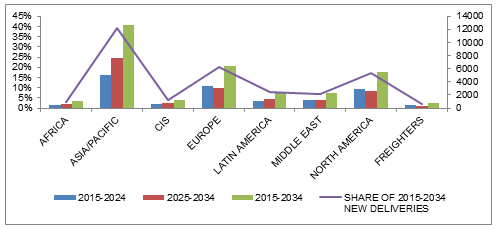
Figure 3: Forecasting Graph
(Source: Subramanian and Gunasekaran 2015, pp-220)
Managers of Airbus organization should adopt the supply chain metric process to measure the complexity lies in the sourcing ad management platforms of the company.
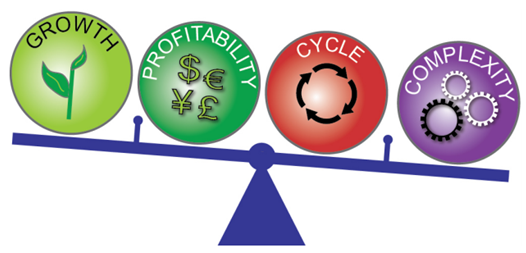
Figure 4: Supply Chain Metrics
(Source: Hou et al. 2014, pp-1175)
Supply Chain Metrics is very useful to capture the performance lack across the supply chain. In order to determine the relationship between chain performance and corporate performance, supply chain metrics is very crucial, as it can align the organizational logistic operations with new model implementations (Huang et al. 2014). As a result, company's growth can be increased regarding larger revenue growth.
The upstream and downstream process of Airbus organization is as follows
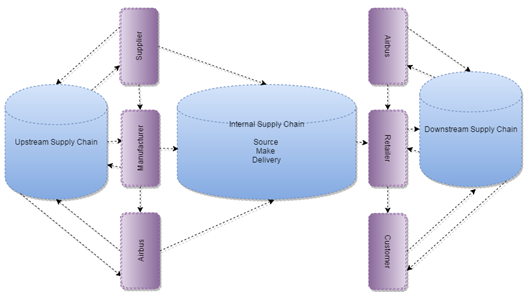
Figure 5: Upstream and Downstream Process of Airbus
(Source: Golicic and Davis 2012, pp-180)
In the upstream process, the aircraft product manufacturers take the raw materials from the suppliers before delivering it to the customer. In the downstream process, products are properly manufactured to be provided to the customers.
After evaluating the current supply chain operation of Airbus organization, implementation of SCRM inside the organization is very necessary to mitigate the challenges from the grass root level (Musa et al. 2012).
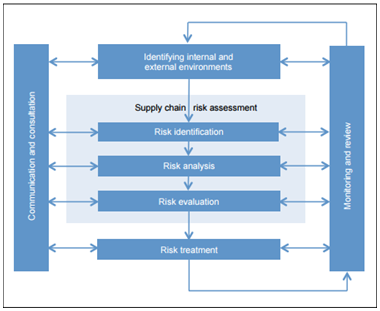
Figure 5: Supply Chain Risk Management
(Source: Abubakar et al. 2012, pp-200)
The SCRM model is very helpful to analyze the internal and external constraints in order to improve the undeveloped areas of the organization. At first, the risk is identified, then it is evaluated and at last, some best solutions are found out to mitigate these problems.
Conclusion
According to the research done on the developmental perspective of the aerospace industry, it is noted that there is a huge growth opportunity for the aerospace industry if the OEMs improve the supply needs for accomplishing the customer needs. On this aspect, new supply chain management model is proposed for Airbus organization to mitigate its internal as well as external challenges. This model can help the organization to provide the best quality of products and services to the customers by reviewing all the marketing and corporate strategies. In turn, this will help to improve the current situation of the organization in an advanced way.
References
Alfalla-Luque, R., Medina-Lopez, C. and Schrage, H., 2013. A study of supply chain integration in the aeronautics sector. Production Planning & Control, 24(8-9), pp.769-784.
Aung, M.M. and Chang, Y.S., 2014. Traceability in a food supply chain: Safety and quality perspectives. Food control, 39, pp.172-184.
Fayezi, S., O'Loughlin, A. and Zutshi, A., 2012. Agency theory and supply chain management: a structured literature review. Supply chain management: an international journal, 17(5), pp.556-570.
Golicic, S.L. and Davis, D.F., 2012. Implementing mixed methods research in supply chain management. International Journal of Physical Distribution & Logistics Management, 42(8/9), pp.726-741.
Gopalakrishnan, K., Yusuf, Y.Y., Musa, A., Abubakar, T. and Ambursa, H.M., 2012. Sustainable supply chain management: A case study of British Aerospace (BAe) Systems. International Journal of Production Economics,140(1), pp.193-203.
Handfield, R.B., Cousins, P.D., Lawson, B. and Petersen, K.J., 2015. How Can Supply Management Really Improve Performance? A Knowledgeâ€ÂBased Model of Alignment Capabilities. Journal of Supply Chain Management,51(3), pp.3-17.
Khajavi, S.H., Partanen, J. and Holmström, J., 2014. Additive manufacturing in the spare parts supply chain. Computers in Industry, 65(1), pp.50-63.
Lavastre, O., Gunasekaran, A. and Spalanzani, A., 2014. Effect of firm characteristics, supplier relationships and techniques used on supply chain risk management (SCRM): an empirical investigation on French industrial firms. International Journal of Production Research, 52(11), pp.3381-3403.
Lengnick-Hall, M.L., Lengnick-Hall, C.A. and Rigsbee, C.M., 2013. Strategic human resource management and supply chain orientation. Human Resource Management Review, 23(4), pp.366-377.
Liu, P., Huang, S.H., Mokasdar, A., Zhou, H. and Hou, L., 2014. The impact of additive manufacturing in the aircraft spare parts supply chain: supply chain operation reference (scor) model based analysis. Production Planning & Control, 25(13-14), pp.1169-1181.
Liu, S., Kasturiratne, D. and Moizer, J., 2012. A hub-and-spoke model for multi-dimensional integration of green marketing and sustainable supply chain management. Industrial Marketing Management, 41(4), pp.581-588.
Madenas, N., Tiwari, A., Turner, C.J. and Woodward, J., 2014. Information flow in supply chain management: A review across the product lifecycle.CIRP Journal of Manufacturing Science and Technology, 7(4), pp.335-346.
Martínez-Jurado, P.J. and Moyano-Fuentes, J., 2014. Lean management, supply chain management and sustainability: a literature review. Journal of Cleaner Production, 85, pp.134-150.
Mena, C., Humphries, A. and Choi, T.Y., 2013. Toward a Theory of Multiâ€ÂTier Supply Chain Management. Journal of Supply Chain Management, 49(2), pp.58-77.
Narasimhan, R., Narayanan, S. and Srinivasan, R., 2013. An investigation of justice in supply chain relationships and their performance impact. Journal of Operations Management, 31(5), pp.236-247.
Subramanian, N. and Gunasekaran, A., 2015. Cleaner supply-chain management practices for twenty-first-century organizational competitiveness: Practice-performance framework and research propositions. International Journal of Production Economics, 164, pp.216-233.
To export a reference to this article please select a referencing stye below:
My Assignment Help. (2017). Supply Chain Management Essay: Airbus Case Study.. Retrieved from https://myassignmenthelp.com/free-samples/supply-chain-management-case-study-of-airbus.
"Supply Chain Management Essay: Airbus Case Study.." My Assignment Help, 2017, https://myassignmenthelp.com/free-samples/supply-chain-management-case-study-of-airbus.
My Assignment Help (2017) Supply Chain Management Essay: Airbus Case Study. [Online]. Available from: https://myassignmenthelp.com/free-samples/supply-chain-management-case-study-of-airbus
[Accessed 18 November 2025].
My Assignment Help. 'Supply Chain Management Essay: Airbus Case Study.' (My Assignment Help, 2017) <https://myassignmenthelp.com/free-samples/supply-chain-management-case-study-of-airbus> accessed 18 November 2025.
My Assignment Help. Supply Chain Management Essay: Airbus Case Study. [Internet]. My Assignment Help. 2017 [cited 18 November 2025]. Available from: https://myassignmenthelp.com/free-samples/supply-chain-management-case-study-of-airbus.
